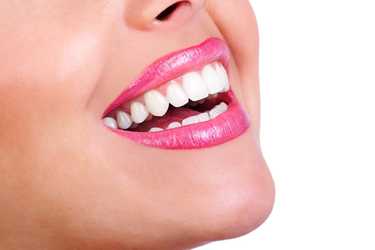 The options for whitening or “bleaching” one’s teeth have become very common today and we have some wonderful techniques in our office for getting great results with our patients’ smiles. However, we still get a lot of questions regarding “the truth” about all of those products you see at the grocery and drugstores, along with questions and doubts about their effectiveness compared to what might seem like “over-priced” professional options. This article will dispel some common myths that we hear, answer some questions, and hopefully address some of the most common problems we see in our office daily with regard to teeth whitening. How does whitening work? Basically, no matter which product you choose, the bleaching chemicals must get down into the tooth enamel and set off a chemical reaction known as oxidation. To do this, most tooth whiteners use one of two chemical agents: carbamide peroxide or hydrogen peroxide (the same stuff that will bleach your hair). When used in the mouth, carbamide peroxide breaks down into hydrogen peroxide and urea, with hydrogen peroxide being the active whitening ingredient. The key to how effective any product is depends on two factors: 1) how strong the solution is, and 2) how long the agent remains against your teeth in order to allow the oxidation process to take place. Typically, the longer you can hold it on there, the closer you can keep it, and the stronger the agent, the better the results. How well do over-the-counter products work? For the most part, the products that you can purchase at your local supermarket do exactly what they claim. The strips cover 6 to 8 teeth, and the effects will last anywhere from 3 to 6 months, with monthly touch-ups, depending upon your own personal habits, both oral hygiene, and the foods and drinks you consume. They seem very affordable, given that your short-term investment is anywhere from $20 to $50, but the concentration is not always listed on the container, so if cost is an issue, try to compare apples to apples. The problem with these systems is not so much in the products themselves, because as we said, they do exactly what they claim to do. The problem we see in our office, is that patients have too high of expectations for these products. Let us give you some examples. Whether you’re using strips or decided to pay a little extra for the trays, the product is not custom designed for your mouth. What does that mean? It means that unless your teeth are perfectly straight, you’re going to get spotty results. Some of the strips can be especially problematic in that they cover only 6-8 teeth per arch, leaving you with a two-tone mouth! When you smile, most people show 10 to 14 teeth per arch. This is especially true when you laugh. Most patients want that younger-looking, beautifully-white, natural-looking smile, with no stain or discoloration showing at all when they’re at a party, wanting to relax and enjoy themselves, or especially at a networking event where impressions matter. The more crowded your teeth are, the more you need the custom trays that only a dentist can provide. Also, you are probably already aware that most over-the-counter medications are weaker, by law, than prescription meds. The same is true for whitening agents. What they are allowed to sell in the grocery store is not the same strength that your dentist can provide. Why does that matter? A stronger agent will give you longer-lasting results, which both makes you happier in the long run and saves you money in the long run. With over-the-counter products, you’ll spend just as much, if not more, as you would with your dentist and you’ll have a lot more hassle with touch-ups as well. The whitening systems used by dentists today can get very satisfying results that last up to 20 years. And if you’re a smoker or heavy coffee drinker, touch-up kits are available in professional formulas as well. What should I know before using an over-the-counter option? The biggest problem we see in our office is when a patient decides to use an over-the-counter method, and then comes in for a cleaning. If you have tartar buildup on your teeth when you whiten, the agent cannot get through to the enamel, so when the tartar comes off, guess what – that’s right, those portions of your teeth are the same color as before you whitened. Very disappointing! So if you are going to use an over-the-counter product, at least get your teeth cleaned immediately before-hand so that you get the best results possible. Another issue we commonly deal with is that even though the over-the-counter whitening solution is weaker than our professional brands, if you have cavities, you will likely experience some extreme sensitivity if you don’t get them taken care of prior to bleaching. Likewise, if you have any issues with your gums, you’ll want to get that taken care of prior to whitening as well, as any amount of peroxide can be irritating to the delicate gum tissue. What about “the light?” More and more patients these days are asking us about “the light.” Some whitening systems have been developed that utilize a high-intensity light to expedite the oxidation process. In our office, we use Deep Bleaching, which is now recognized all over the world as the most effective whitening technique ever invented. The technique is so effective that it will even whiten tetracycline discolored teeth, (which were previously thought to be impossible to bleach), in a short period of time. Just imagine getting your teeth MUCH whiter, and having it last for your ENTIRE life! With very simple periodic maintenance at home, the results are entirely permanent. Take-home whitening systems can be just as effective, but usually require wearing your custom trays with the bleaching solution for about 1 hour per day, for 14 days. Newer professional products require only 3 minutes per day for 14 days. There are many combinations of time frames and systems available, but Dr. Moorhead can help determine what is going to work best for you. Are there any “down-sides” to professional whitening? None of these systems, professional or over-the-counter, work on white fillings, crowns, veneers, and certain spots. Only in-office deep bleaching can whiten tetracycline stains. In the case of spots and stains that will not respond to the oxidation process, Dr. Moorhead might recommend crowns or veneers; the course of treatment most suitable for you. If you’re having white fillings or veneers placed soon, you’ll want to have your whitening completed before choosing the final shade for your cosmetic work. Sensitivity can be a problem with any of these systems. Dr. Moorhead will work with you to find a solution that is acceptable to you, and can provide fluoride to help strengthen your teeth and reduce sensitivity. Is whitening my teeth safe from an oral health perspective? Most studies show that tooth whitening is both safe and effective. If tooth sensitivity or gum irritation occur, it is best to stop using the whitening product for a few days, and then start again, but less frequently — say, every other day instead of every day — and reduce the amount of time spent with the whitening agent against your teeth. These are the most common questions and concerns raised by our patients, but we’d love to hear from you! If you have a question or comment about specific whitening options for your teeth, please contact us at Flemingsburg Dental Care.
0 Comments
Leave a Reply. |
Articles
All
AuthorDr. Moorhead and his team write about dental news, and answer patient questions. Archives |

 RSS Feed
RSS Feed